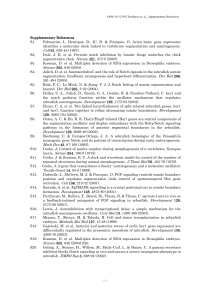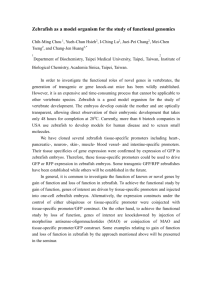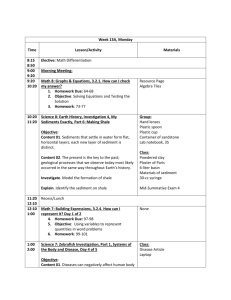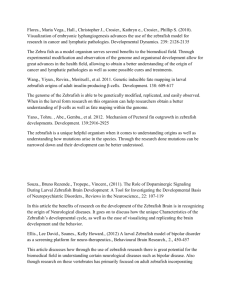Presentation
advertisement
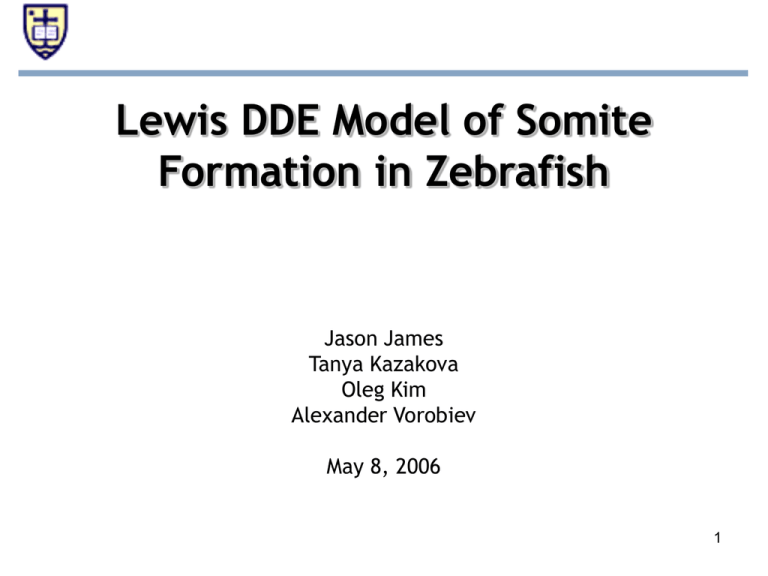
Lewis DDE Model of Somite Formation in Zebrafish Jason James Tanya Kazakova Oleg Kim Alexander Vorobiev May 8, 2006 1 Outline ▀ About the Model ▀ Biological background ►What are zebrafish? ►Why should we care about somitogenesis? ►Temporal and spatial coupling Jason James - JJ Tanya Kazakova - TK Oleg Kim - OK Alexander Vorobiev - AV ▀ Model set up ►About gene expression ►Notch pathway ►Modeling Oscillatory Mechanism ► JJ ▀ Mathematical Model ►ODE and DDE Models ►Motivation and mechanism of delays ►Numerical results ▀ Conclusions and applications ▀ Movie time! 2 TK About “Autoinhibition with Transcriptional Delay: A Simple Mechanism for the Zebrafish Somitogenesis Oscillator” by Julian Lewis Julian Lewis Vertebrate Development Laboratory Cancer Research UK London Research Institute Current Biology, Vol. 13, 1398–1408, August 19, 2003 3 JJ The Zebrafish • The Zebrafish, also called Zebra Danio, is a tropical fish belonging to the minnow family. • The fish is known for its distinctive horizontal stripes extending across the length of its entire body. • Zebrafish have few commercial or food purposes, but are ideal for keeping in an aquarium because of its popularity, low price, and low maintenance physical constitution. 4 JJ The Zebrafish • The Zebrafish originates from eastern India and inhabits bodies of fresh water such as streams, ponds, and canals. • The Zebrafish can grow to be six centimeters long and can live for up to five years. 5 JJ The Zebrafish • The Zebrafish holds great value as a model organism in the studies of vertebrate development and genetics. • A Zebrafish egg becomes a larvae in three days. • This speedy development facilitates research. In Lewis’ case, a Zebrafish’s period of oscillation takes 30 minutes compared to 90-120 minutes for a mouse or chick. • Another consequence of the Zebrafish’s fast development is a simpler, more easily observed chain of transcriptional regulation. 6 JJ Fun facts about the Zebrafish • A Zebrafish embryo is transparent, allowing researchers to see results of genetic experiments in less than three days. • The Zebrafish is one of the a select group of animals to have ventured into outer space. • The Zebrafish has been genetically engineered into the Glofish, a brightly fluorescent fish. • A melanin-producing gene in Zebrafish has also been found in humans and segregates strongly between light skin and dark skin. 7 JJ Somites in vertebrate embryos • Somites lie on either side of the neural tube in vertebrate embryos, including humans, in head to tail succession. • The somites develop into dermis, skeletal muscle, and the vertebrae. • The segmented pattern in somites is determined by cyclic changes in gene expression in the presomitic mesoderm. 8 JJ Segmentation and somitogenesis • During segmentation, the embryo of an organism becomes subdivided into similarly-appearing tissue modules. • During somitogenesis, the presomitic mesoderm of a vertebrate segments into parallel blocks of tissue. • Some blocks of tissue retain a segmented appearance, such as the spinal cord, while others do not, such as skin. 9 JJ Segmentation and somitogenesis • Somite segmentation is dictated by a kind of molecular clock in all vertebrate embryos. • This ‘clock’ takes the form of a transcriptional oscillator in the presomitic mesoderm. Most genes that participate in this oscillator belong to a certain set called the Notch pathway. • In particular, Lewis has examined the her1 and her7 genes in the Zebrafish. 10 JJ Mathematical model • Lewis has developed a model for the mechanism of expression of the her1 and her7 genes which serves to explain certain observations about somitogenesis in Zebrafish. • According to the model, the period of oscillation in the molecular clock amounts to a system with delay – the delays of transcription and translation, i.e., the amount of time needed to construct the mRNA molecule and the protein molecule. 11 AV Temporal + spatial • Dynamic behavior of gene expression • Clock and wavefront mechanism • The cell oscillation components belongs to the Notch Signaling Pathway • PSM cells may continue oscillate without their neighbors 12 AV Gene expression and mRNA • Gene expression, (protein expression or simply expression) is the process by which a gene's DNA sequence is converted into the structures and functions of a cell. • The expression of particular genes may be estimated by measurement of the cellular concentration of messenger RNAs (mRNA). 13 AV Notch pathway - cell communication mechanism. 14 AV Time scales - transcriptional and the translational delays • Stages: transcription of DNA, into messenger RNA, post transcriptional modification, translation, folding, post-translational modification and targeting. • Degradation: After a certain amount of time the message degrades into its component nucleotides. 15 AV Notch pathway • The Notch pathway is a gene regulatory pathway involved in multiple differentiation processes. • The Notch protein sits like a trigger penetrating the cell membrane, with part of it inside and part outside. Proteins when binding to the exterior part cause the interior part to release other proteins, which typically then make their way to the cell nucleus to alter gene expression. 16 OK Zebrafish Somitogenesis Oscillator The pattern of somites is traced out by a mechanism involving oscillating gene expression at the tail end of the embryo. In zebrafish two linked oscillating genes, her1 and her7, coding for inhibitory gene regulatory proteins, are especially implicated in genesis of the oscillations, while Notch signaling appears necessary for synchronization of adjacent cells. 17 OK Stages of embrionic development of the zebrafish 18 TK Mathematical Model: ODE Variables: m – the number of mRNA molecules in the cell at any instant p - be the number of molecules of the corresponding protein Constants: b,c – decay rates (inverse lifetimes) k,p0 – constants representing the action of an inhibitory protein dp am bp dt dm f ( p) cm dt k f ( p) p2 1 2 p0 f(p) – rate of production of new mRNA molecules 19 TK Plausible Parameter Values • a = 4.5 protein molecules per mRNA molecule per minute • b = c = 0.23 molecules per minute, corresponding to protein and mRNA half-lives of 3 min • k = 33 mRNA molecules per diploid cell per minute corresponding to 1000 transcripts per hour per gene copy in the absence of inhibition • p0 = 40 molecules, corresponding to a critical concentration of ~10-9 M within a 5 mdiameter cell nucleus 20 TK Mathematical Model: DDE Constants: Tm – time that elapses between the initiation of transcription and the arrival of the mature mRNA molecule in cytoplasm Tp – delay between the initiation of translation and the emergence of a complete functional protein molecule dp (t ) am(t T p ) bp (t ) dt dm f ( p (t Tm )) cm(t ) dt k f ( p) p2 1 2 p0 Values: 10.2 < Tmher1 < 31.5 min Tphe1 ~ 2.8 min 21 Oscillator: Illustrating Basic Principles The Period is determined by the delay in the feedback loop. A) On/of switch. Transition to the “on” state creates a delayed negative feedback signal, causing transition to the “off” state after time T, and vice versa; the time for one complete cycle (on->off->on) is 2T. 22 OK OK Oscillator: Illustrating Basic Principles B) System described by a continuous variable, x(t), autoregulated by negative feedback with delay T such that x(t) = f (x(t - T)), where f is a monotonically decreasing function. If, for example, f(x) = K/(1+x2), oscillations will be sustained and will have period 2T whenever K >2. (This is the condition under which the pair of equations x1= f[x2] and x2 = f[x1] has solutions x1≠x2; the system then alternates between state x = x1 and state x 23 = x2). OK Oscillator: Illustrating Basic Principles C) A chemical system in which the rate of synthesis of substance x is regulated by delayed negative feedback and degradation occurs at rate cx(t): dx f ( x(t T )) cx (t ) dt 24 TK Model without noise 25 TK Including noise 26 JJ Conclusions and applications • The systems investigated by Lewis, despite their simplicity in Zebrafish, often exhibit surprising behaviors. • The mathematical model offered by Lewis attempts to more completely understand somitogenesis and suggests a method to describe other oscillations in vertebrate embryos which currently go undetected by standard means. • A more complete understanding of the segmentation clock within an embryo will greatly contribute to the overall understanding of the very earliest stages of human and animal life. 27 Movie 28

